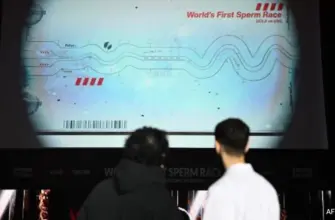A groundbreaking study suggests that early humans utilized a rudimentary form of sunscreen over 40,000 years ago, potentially contributing to their survival and the extinction of Neanderthals.
Researchers at the University of Michigan have uncovered evidence indicating that *Homo sapiens* applied ochre—a naturally occurring earth pigment—to their skin as protection from intense solar radiation. This practice, combined with other adaptive behaviors like cave dwelling and the development of tailored clothing, may explain why modern humans endured while Neanderthals disappeared around 40,000 years ago.
The surge in protective measures aligns with a significant geological event: the Laschamps excursion, which occurred approximately 41,000 years ago. During this period, Earth’s magnetic field temporarily weakened and shifted, exposing the planet to dramatically higher levels of ultraviolet radiation.
The Laschamps excursion resulted in a reversal of Earth’s magnetic poles, reducing its strength to just 10% of its current level for roughly 1,000 years. Normally, this magnetic field shields us from harmful solar and cosmic rays; the weakened state created a dangerous environment.
“The magnetic poles even migrated towards the Equator during this time,” explains Dr. Agnit Mukhopadhyay, a climate and space sciences expert. “This led to unusual auroral displays visible across Europe and into northern Africa.”
Archaeological evidence reveals that *Homo sapiens* proactively adapted to these challenging conditions:
- Developed tailored clothing—supported by the discovery of hide-scraping stones, needles, and awls used for sewing. These tools are notably absent from Neanderthal sites.
- Increased use of caves as shelter.
- Utilized ochre as a protective pigment on their skin.
Tailored clothing provided not only UV protection but also warmth, allowing humans to expand their foraging range beyond immediate shelters.
“There is limited evidence that Neanderthals adopted similar strategies,” researchers noted.
As Dr. Raven Garvey, an associate professor of anthropology at the University of Michigan, points out: “Experimental tests have demonstrated that ochre possesses sunscreen-like qualities and has been used for this purpose by various cultures throughout history.”
Dr. Mukhopadhyay added, “The regions where we see increased cave usage and ochre application closely correlate with early human activity around 41,000 years ago.”
The study, published in *Science Advances*, proposes that these protective measures provided a critical evolutionary advantage for *Homo sapiens*.
“It’s important to emphasize that our findings are correlational,” cautions Dr. Garvey. “However, they offer a new interpretation of existing data within the context of the Laschamps excursion.”

